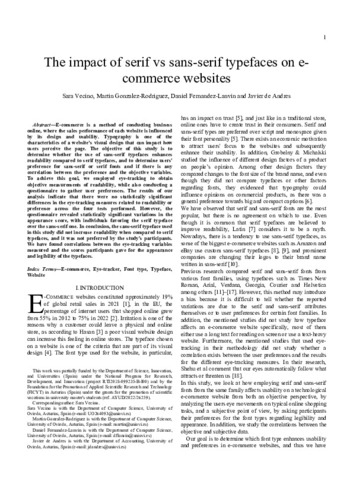The Impact of Serif vs Sans-Serif Typefaces on e-Commerce Websites
Subject:
Human-computer interaction, serif, sans-serif, typefaces
Publication date:
Publisher version:
Citación:
Descripción física:
Abstract:
E-commerce is a method of conducting business online, where the sales performance of each website is influenced by its design and usability. Typography is one of the characteristics of a website’s visual design that can impact how users perceive the page. The objective of this study is to determine whether the use of sans-serif typefaces enhances readability compared to serif typefaces, and to determine users’ preference for sans-serif or serif fonts and if there is any correlation between the preference and the objective variables. To achieve this goal, we employed eye-tracking to obtain objective measurements of readability, while also conducting a questionnaire to gather user preferences. The results of our analysis indicate that there were no statistically significant differences in the eye-tracking measures related to readability or preference across the four tests performed. However, the questionnaire revealed statistically significant variations in the appearance score, with individuals favoring the serif typeface over the sans-serif one. In conclusion, the sans-serif typeface used in this study did not increase readability when compared to serif typefaces, and it was not preferred by the study’s participants. We have found correlations between the eye-tracking variables measured and the scores participants gave for the appearance and legibility of the typefaces.
E-commerce is a method of conducting business online, where the sales performance of each website is influenced by its design and usability. Typography is one of the characteristics of a website’s visual design that can impact how users perceive the page. The objective of this study is to determine whether the use of sans-serif typefaces enhances readability compared to serif typefaces, and to determine users’ preference for sans-serif or serif fonts and if there is any correlation between the preference and the objective variables. To achieve this goal, we employed eye-tracking to obtain objective measurements of readability, while also conducting a questionnaire to gather user preferences. The results of our analysis indicate that there were no statistically significant differences in the eye-tracking measures related to readability or preference across the four tests performed. However, the questionnaire revealed statistically significant variations in the appearance score, with individuals favoring the serif typeface over the sans-serif one. In conclusion, the sans-serif typeface used in this study did not increase readability when compared to serif typefaces, and it was not preferred by the study’s participants. We have found correlations between the eye-tracking variables measured and the scores participants gave for the appearance and legibility of the typefaces.
ISSN:
Patrocinado por:
This work was partially funded by the Department of Science, Innovation, and Universities (Spain) under the National Program for Research, Development, and Innovation (project RTI2018-099235-B-I00) and by the Foundation for the Promotion of Applied Scientific Research and Technology (FICYT) in Asturias (Spain) under the grants for the promotion of scientific vocations in university master’s students (ref. AYUD/2022/26259).
Collections
- Artículos [37543]
- Informática [872]
- Investigaciones y Documentos OpenAIRE [8370]
Files in this item





